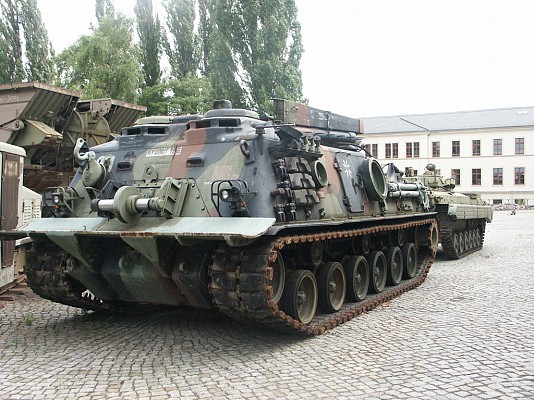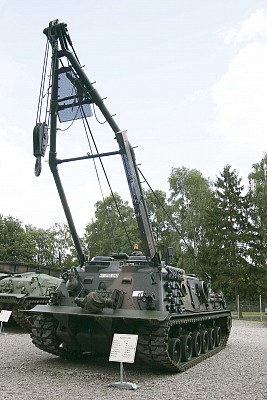M88
Bergepanzer 1
Overview

Bergepanzer 1
Austrian army Bergepanzer 1 seen on the move during an exercise in 1999.
Source: Nxr-at -
© CC BY-SA 4.0
1975 for M88A1
1973 for M88A1
1977 - 1989 for M88A1
1.075 M88 for US military
876 M88 updated to M88A1
BPz 1 / Bergepanzer 1 (German service)
Germany
Egypt
Saudi Arabia
Description
Introduction
The M88 is an early Cold War era armored recovery vehicle of US origin. It was developed to replace the M74 based on the Sherman chassis in US military service. The M88 served in support of the M60 Patton series of main battle tanks, with which it shares the chassis and many automotive components. The M88A2 Hercules is a deep modernization and is described in a separate article.
Design
The M88 is based on the chassis of the M60 Patton main battle tank. However, the drivetrain of the M51 heavy recovery vehicle with its petrol engine is fitted. A large square welded superstructure is located at the front and seats the crew of four. A large A-frame crane jib is mounted over the superstructure and is operated using a 23 t secondary winch. The main winch has a 41 t capacity. The dozer blade at the front doubles as an earth anchor for winching operations and as stabilizer for lifting operations.
Firepower
For self-defense a 12.7mm M2HB heavy machine gun is mounted. The flexible mount allows for use against aircraft and ground targets.
Protection
The M88 has steel armor. The superstructure is welded while the lower hull is mostly cast armor. The armor is not as thick as on the M60 Patton main battle tank. The armor protects against heavy machine gun fire, small arms fire and shell splinters all around.
Mobility
With its tracked chassis the M88 can traverse the same difficult terrain as the main battle tanks it is to support. The petrol engine of the original M88 gave it a lower operational range than the M88A1, which was fitted with a diesel engine.
Users
The M88 was acquired in large numbers by the US military, with 1.075 acquired in the early 1960's. These replace the M74 which was unable to adequately support the M48 and M60 Patton tanks. The M88 was also exported to several nations. The M88A1 was both rebuilt from exiting M88 and built new from factory. About dozen nations acquired this early generation of M88. In US military service it was replaced by the M88A2 HERCULES, which was also sold to some other nations.
Variants

M88
First production model of the M88, introduced in 1961. This model features the 980 hp petrol engine, proving a good power to weight ratio at the cost of a high fuel consumption.

M88A1
Improved variant of the M88 that was first introduced in 1975. This was both produced as a new vehicle and also the majority of existing M88 were converted to this standard. The main change is the use of the same 750 hp diesel engine as found on the M60 Patton. This reduces maximum speed but has a vastly improved mileage.

Bergepanzer 1
West Germany acquired the M88 and designated it the Bergepanzer 1. The differences were minor, such as adding different smoke grenade launchers and a 7.62mm MG3A1 machine gun. Germany also opted for a M88A1-style improvement program, but with a MTU diesel engine. The capacity of the winch and hoist were also updated during a refit program.

M88A2 HERCULES
Deep modernization of the M88 design that makes it a heavy recovery vehicle. This was introduced in 1991 to support the much heavier M1 Abrams series of main battle tanks. The HERCULES differs in so many areas that it is described in a separate article.
Details
Media
Related articles

M60 Patton
The M88 armored recovery vehicle is based on the chassis of the M60 Patton main battle tank.















